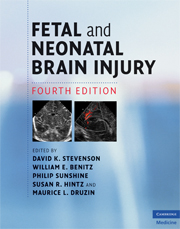Book contents
- Frontmatter
- Contents
- List of contributors
- Foreword
- Preface
- Section 1 Epidemiology, pathophysiology, and pathogenesis of fetal and neonatal brain injury
- Section 2 Pregnancy, labor, and delivery complications causing brain injury
- Section 3 Diagnosis of the infant with brain injury
- Section 4 Specific conditions associated with fetal and neonatal brain injury
- Section 5 Management of the depressed or neurologically dysfunctional neonate
- 39 Neonatal resuscitation: immediate management
- 40 Improving performance, reducing error, and minimizing risk in the delivery room
- 41 Extended management following resuscitation
- 42 Endogenous and exogenous neuroprotective mechanisms after hypoxic–ischemic injury
- 43 Neonatal seizures: an expression of fetal or neonatal brain disorders
- 44 Nutritional support of the asphyxiated infant
- Section 6 Assessing outcome of the brain-injured infant
- Index
- Plate section
- References
42 - Endogenous and exogenous neuroprotective mechanisms after hypoxic–ischemic injury
from Section 5 - Management of the depressed or neurologically dysfunctional neonate
Published online by Cambridge University Press: 12 January 2010
- Frontmatter
- Contents
- List of contributors
- Foreword
- Preface
- Section 1 Epidemiology, pathophysiology, and pathogenesis of fetal and neonatal brain injury
- Section 2 Pregnancy, labor, and delivery complications causing brain injury
- Section 3 Diagnosis of the infant with brain injury
- Section 4 Specific conditions associated with fetal and neonatal brain injury
- Section 5 Management of the depressed or neurologically dysfunctional neonate
- 39 Neonatal resuscitation: immediate management
- 40 Improving performance, reducing error, and minimizing risk in the delivery room
- 41 Extended management following resuscitation
- 42 Endogenous and exogenous neuroprotective mechanisms after hypoxic–ischemic injury
- 43 Neonatal seizures: an expression of fetal or neonatal brain disorders
- 44 Nutritional support of the asphyxiated infant
- Section 6 Assessing outcome of the brain-injured infant
- Index
- Plate section
- References
Summary
Introduction
Nearly all infants are exposed to periods of compromised gas exchange before and during labor (seeChapter 13), and yet only a remarkably small minority of newborns develop hypoxic–ischemic encephalopathy (HIE). Indeed, even severe metabolic acidosis at birth is associated with HIE in less than half of cases. Similarly, experimental studies typically report that cerebral injury occurs only in a very narrow temporal window between survival with complete recovery and death. Partly this is a reflection of the efficiency of the fetal adaptations that maintain perfusion to the essential organs. Partly, an acute event activates a cascade not only of damaging processes but also of protective endogenous processes that help limit neural injury, as illustrated in Figure 42.1. These processes may be modified, raising the possibility of treating acute encephalopathy.
Biphasic cell death after hypoxic–ischemic injury
The seminal observation, both from experimental studies in vivo and in vitro, and from clinical observations, is that HIE is not a single “event” but rather an evolving process. During actual hypoxia–ischemia (which may be termed the “primary” phase of the insult) high-energy metabolites are depleted, with progressive depolarization of cells, severe cytotoxic edema (cell swelling), and extracellular accumulation of excitatory amino acids (EAAs) due to failure of reuptake by astroglia and excessive depolarization-mediated release.
- Type
- Chapter
- Information
- Fetal and Neonatal Brain Injury , pp. 485 - 498Publisher: Cambridge University PressPrint publication year: 2009



